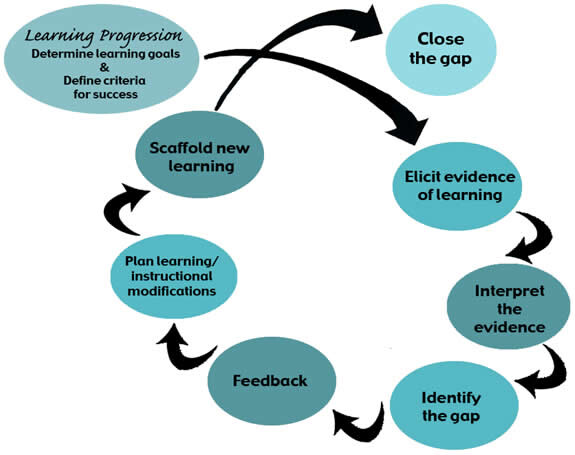On this page...
Formative Assessment is a process used by teachers and students as part of instruction that provides feedback to adjust ongoing teaching and learning to improve students’ achievement of core content. As assessment for learning, formative assessment practices provide students with clear learning targets, examples and models of strong and weak work, regular descriptive feedback, and the ability to self-assess, track learning, and set goals. (Adapted from Council of Chief State School Officers, FAST SCASS)

Intended Purpose
- To increase students' learning
- To adjust instruction
- To diagnosis student needs
- To improve the instructional program
Examples
- Non-graded quizzes
- Pretests, minute papers
- Exit tickets
- Written assignments
- Concept maps
- Interviews
- Progress monitoring
- Performance assessment scoring guides
- Weekly reports
- Focused questions
- Journals
- Learning logs
- Learning probes
- Checklists
- Surveys
- Item analyses of summative assessments
Research has shown that effective assessment for learning practices have the potential to greatly increase both student achievement and motivation. Black and Wiliams (1998) identify the key classroom assessment features that result in these large achievement gains as:
- Assessments that result in accurate information
- Descriptive rather than evaluative feedback to students
- Student involvement in assessment
Strategies
For classroom formative assessment practices to both motivate students and increase student achievement, students need to know the learning target, know where they are at in regards to the learning target, and know what they can do to close the gap. In Classroom Assessment for Student Learning, Richard J. Stiggins lists 7 strategies of assessment for learning. They are as follows:
- Provide a clear and understandable vision of the learning targets.
- Use examples and models of strong and weak work.
- Offer regular descriptive feedback.
- Teach students to self-assess and set goals.
- Design lessons to focus on one aspect of quality at a time.
- Teach students focused revision.
- Engage students in self-reflection, and let them keep track of and share their learning.
Connections
Formative assessment is an integral part of the following initiatives in Iowa Schools:
Multi-Tiered System of Supports
Multi-Tiered System of Supports (MTSS) in Iowa, also known as Response to Intervention or RtI, is an every-education decision-making framework of evidence-based practices in instruction and assessment that addresses the needs of all students starting in general education. A key component of MTSS is evidence-based curriculum and instruction. To keep learning moving forward each student needs continuous monitoring of on-going learning. With each lesson, MTSS teachers identify the intended learning, use evidence of students meeting the learning goals, and identify which students need additional support, are on track to learn, or need to move forward. Teachers using formative assessment practices are also able to engage students in thinking and acting on their learning needs.
Back to top